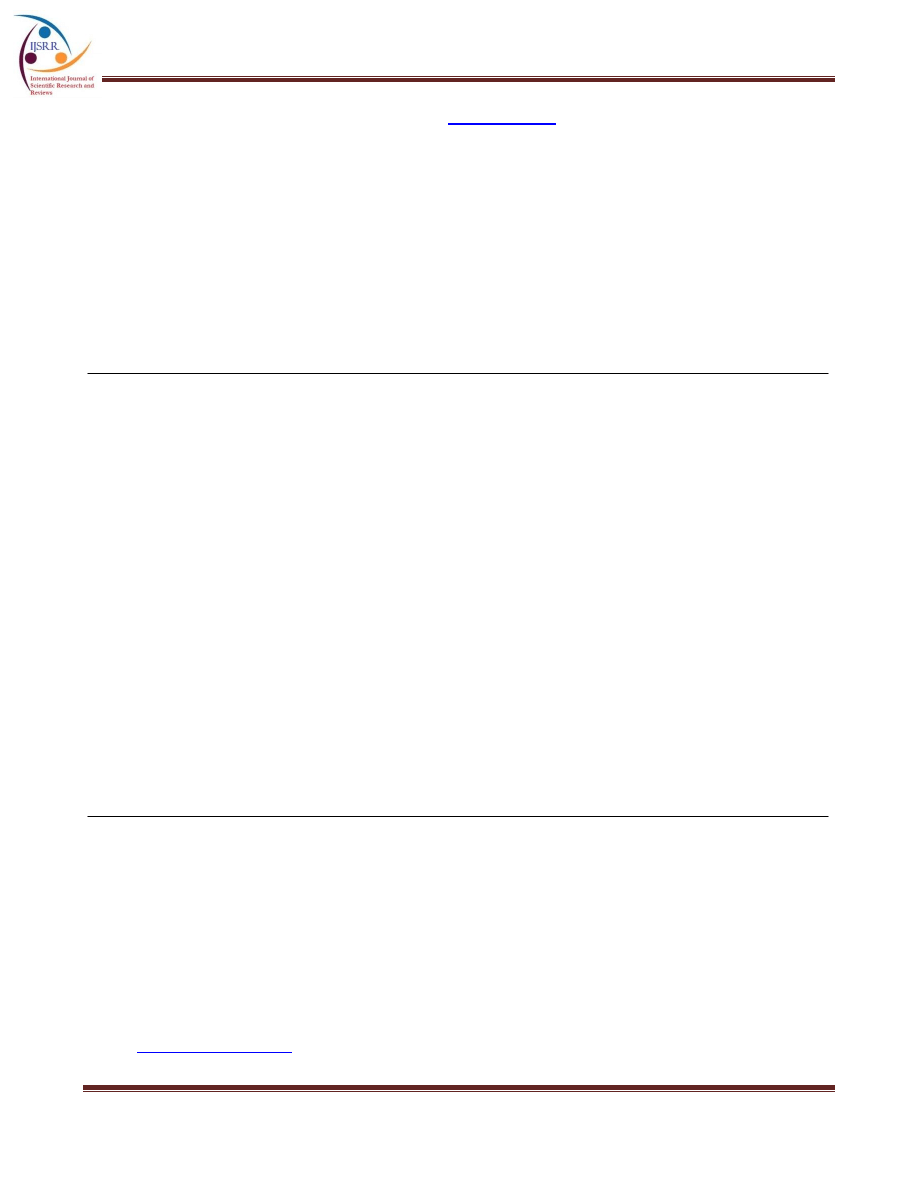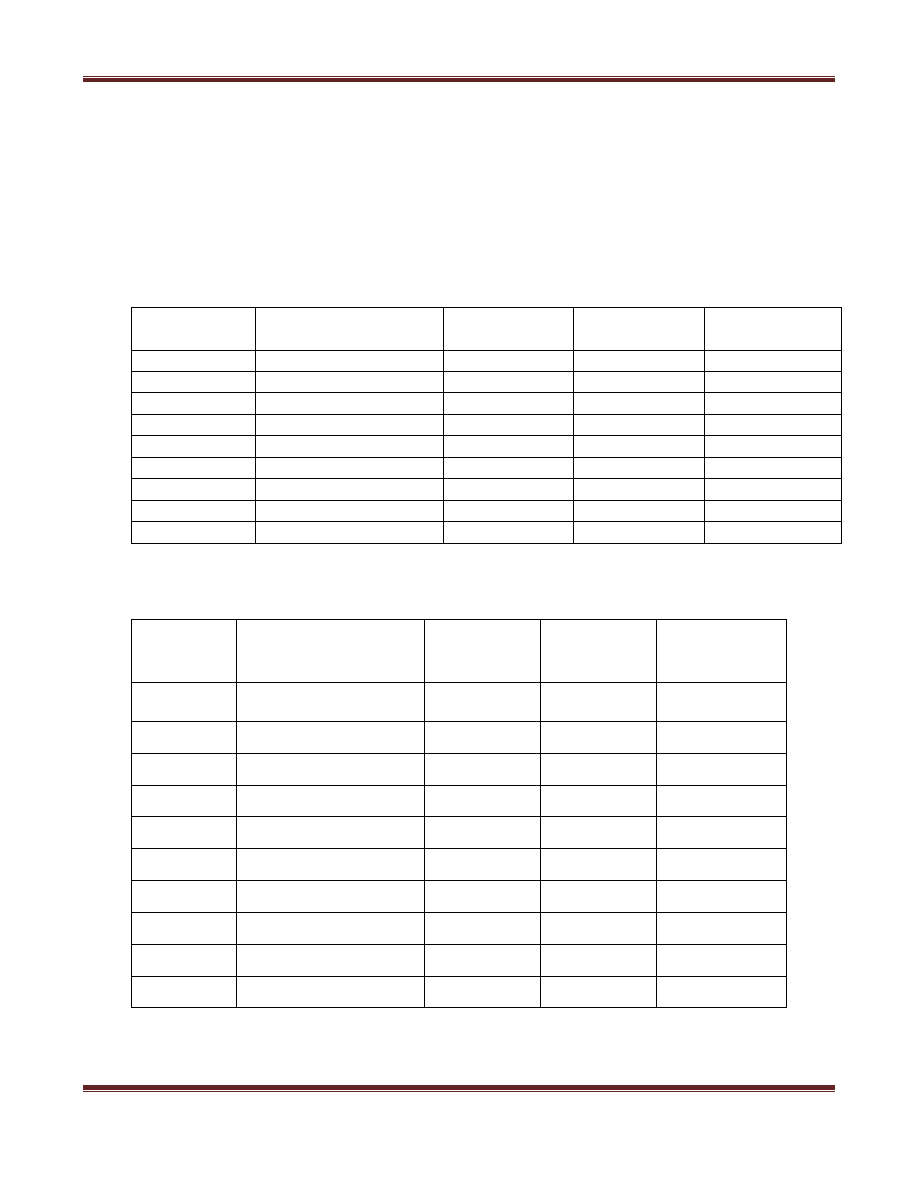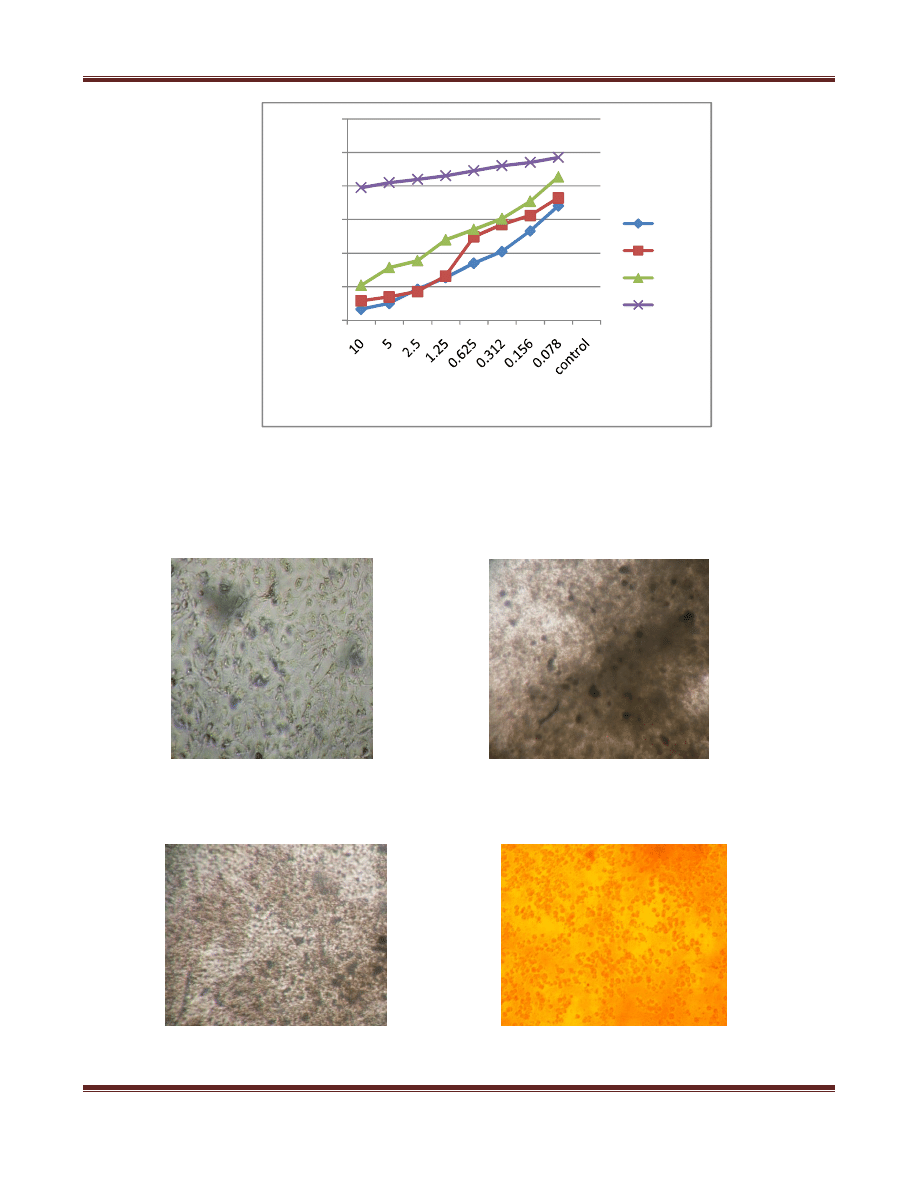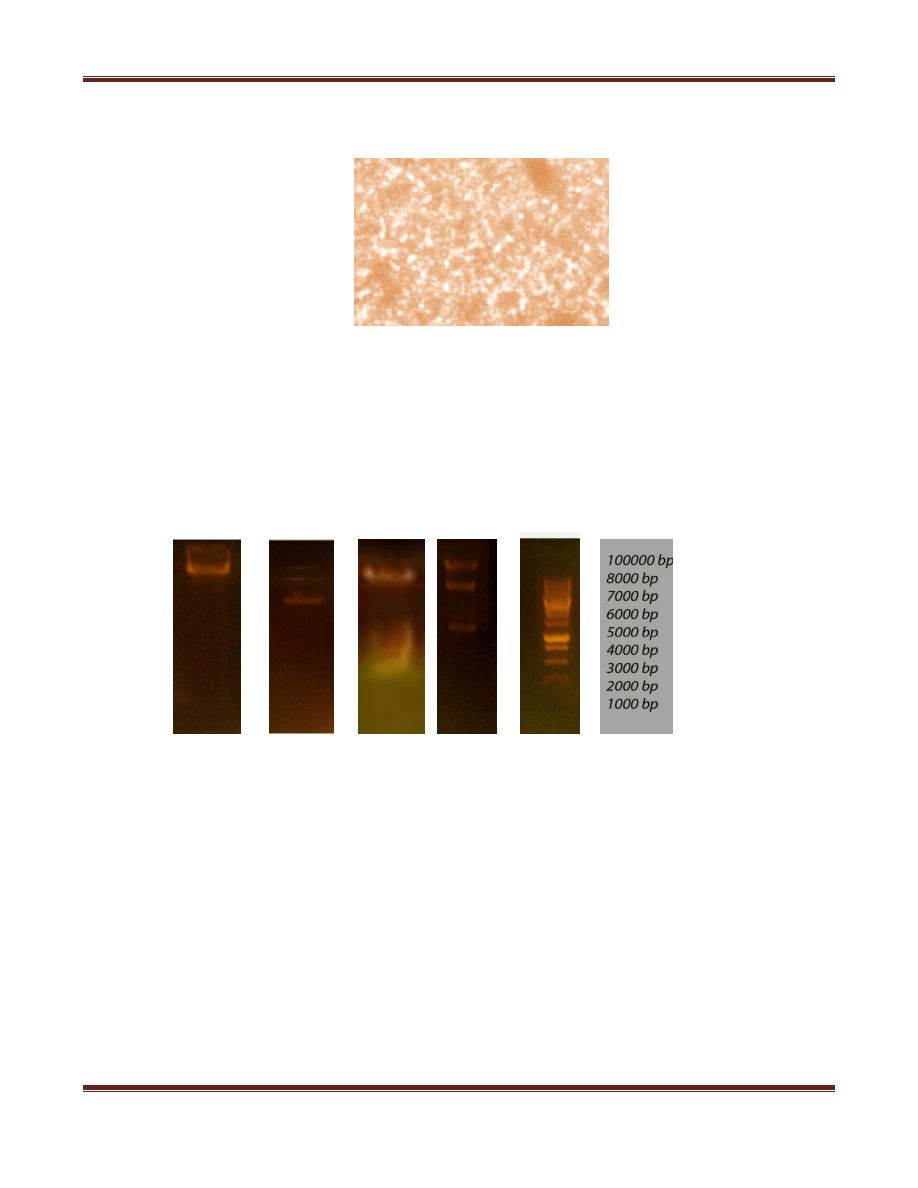
Kanimozhi D. et al. IJSRR 2012, 1(1), 10-23
IJSRR 1(1) APRIL-JUNE 2012
Page 10
Research article
Available online
www.ijsrr.org
ISSN: 2279-0543
International Journal of Scientific Research and Reviews
In-Vitro Anticancer Activity of Ethanolic Extract of Cynodon dactylon
Against HEP-2, HELA and MCF-7 Cell Lines.
Kanimozhi D*
Department of Zoology, Presidency College, Chennai-600 005, Tamilnadu, India.
ABSTRACT:
The aim of the present study is to evaluate the effect of in-vitro anticancer activity of the ethanolic
extract of Cynodon dactylon against HEP-2 laryngeal, HELA cervical and MCF-7 breast cancer cell
lines and it was compared with normal, Vero cell line using MTT assay showed a percentage of cell
viability of 97 % at 0.078mg/ml which decrease with increase in concentration of extract. Anticancer
activity of ethanolic extract of Cynodon dactylon on HEP-2, HELA and MCF-7 cancer cell lines
showed potent cytotoxic activity. The inhibition percentage with regard to cytotoxicity was found to be
93.5%, 88.5% and 79.2% at 10mg/ml, which was comparable to the control Cyclophosphamide that
showed a cytotoxicity of 96%, 92% and 83% Therefore the minimum effective concentration of
ethanol extract of Cynodon dactylon was non-toxic to Vero cells but toxic to HEP-2, HELA and MCF-
7 cells(Ic50) was recorded at a concentration of 0.156mg/ml 0.625mg/ml of the ethanolic extract of
Cynodon dactylon. Among these three cell lines Cynodon dactylon shows more activity in HEP-2
laryngeal cell line.
KEYWORDS:
Cynodon dactylon, HEP-2, MCF-7 cell lines, MTT assay, DNA Fragmentation
*
Corresponding Author
:
Kanimozhi.D
Department of Zoology, Presidency College,
Chennai-600 005, Tamilnadu, India.
Email:
kanphd5@gmail.com
,
Telephone: 09884544544

Kanimozhi D. et al. IJSRR 2012, 1(1), 10-23
IJSRR 1(1) APRIL-JUNE 2012
Page 11
INTRODUCTION:
Plant derived agents are being used for the treatment of cancer. Several anticancer agents from plants
include, taxol, vinblastine, vincristine, the camptothecin derivatives, topotecan and irinotecan, and
etoposide derived from epipodo phyllotoxin are in clinical use all over the world. Numerous cancer
research studies have been conducted using traditional medicinal plants in an effort to discover new
therapeutic agents that lack the toxic side effects associated with current chemotherapeutic agents.
Scutellaria baicalensis was used as a component of PCSPES, an herbal mixture that showed efficacy
in laboratory trials for prostate cancer, small-cell lung cancer and acute myeloid leukemia
1-6
. Although
more than 1500 anticancer drugs are in active development with over 500 of the drugs under clinical
phytomedicines has increased dramatically in the last two decades
7
. It has been also reported
8
that
more than 50% of all modern drugs in clinical use are of natural products, many of which have been
recognized to have the ability to include apoptosis in various cancer cells of human originals, there is
an urgent need to develop much effective and less toxic drugs . Invitro studies
9
. Geinstien in plants
such as parsley and soy foods inhibits protein tyrosine kinase, thereby disrupting signal transduction
and inducing cell differentiation
10,11
.
Cynodon dactylon .Pers. belongs to the family of Poaceae
12
and is said to have many medicinal
properties including Antihelmentic
13
, Antidiuretic, Antiinflammatory, Hepatoprotective activity
14
as
well as treatment of Urinary tract infections
15
, Prostatitis, and Dysentery. Traditionally it is used in
diabetes
16,17
jaundice
, kidney problems
18
, urinary disease, gastrointestinal disorder
19
, Constipation and
abdominal pain. The whole plant is used for diuretic, dropsy, syphilis, wound infection and piles.
Cynodon dactylon is used as antihaemorrhagic in dysentery and nasal bleeding
20
. The juice of the plant
is astringent and is applied externally to fresh cuts and wounds. It is used in the treatment of catarrhal
opthalmia, hysteria, epilepsy, insanity,and chronic diarrhea . The plant is folk remedy for anasarca,
calculus,carbuncles, cough, hypertension, snake bites, gout and rheumatic affections. Cynodon dactylon
is a valuable herbal medicine and used for first aid for minor injuries
21,22
.Cynodon dactylon is bitter,
sharp hot taste, good odor, laxative, brain and heart tonic, aphrodisiac, expectorant, carminative and
useful against grippe in children and for pains, inflammations, and toothache
23
.
Virus-affected discolored leaves of Cynodon are used for the treatment of liver complaints. In
Homoeopathic systems of medicine, it is used to treat all types of bleeding and skin troubles
24
. The
Ethanolic extract of aerial parts of C.dactylon showed marked protection against convulsions induced
by chemo convulsive agents in mice
25
. Ethanolic extract of defatted C. dactylon has high antidiabetic

Kanimozhi D. et al. IJSRR 2012, 1(1), 10-23
IJSRR 1(1) APRIL-JUNE 2012
Page 12
potential along with good hypolipidemic profile
26
. This suggests the potential for Cynodon dactylon to
become an alternative to current diabetes medications. The methanolic extract of Cynodon dactylon
possessed significant antitumor activity and hepatoprotective effect against Ehrlich ascitic Lymphoma
(ELA) in Swiss albino mice and brought back the altered levels of the hematological parameters and
liver enzymes
27
. Aqueous and ethanolic extract of C. dactylon (500µg/ml) were investigated for their
antibacterial activity against gram positive bacteria and gram negative bacteria using disc diffusion,
well in agar and microdilution method. E. coli, B. subtilis, S. aureus and A. hydrophila were more
susceptible in the ethanolic extract and no result was found in aqueous extract
28
. Invitro cytotoxic of
the root extract of Rubia cordifolia exhibited significant cytotoxic activity against Hep-2 cell line
29
.
The fruits of Solanum nigrum methanolic extract were tested for its inhibitory effect on HeLa Cell
Line. The cytotoxicity of Solanum nigrum on HeLa cell was evaluated by the SRB assay and MTT
assay. Solanum nigrum methanolic extract has significant cytotoxicity effect on HeLa Cell Line in
concentration range between10mg/ml to 0.0196mg/ml by using SRB assay and study also showed that
inhibitory action on HeLa cell line in concentration range between 10 mg/ml to 0.0196mg/ml by using
MTT assay
30
. The antioxidant and anticancer activities were assessed for two Bangladeshi ginger
varieties (Fulbaria and Syedpuri) at young age grown under ambient (400µmol/mol) and elevated
(800µmol/mol) CO
2
concentrations against two human breast cancer cell lines (MCF-7 and MDA-MB-
231)
31
.
MATERIALS AND METHODS:
Reagents:
MEM was purchased from Hi Media Laboratories Fetal bovine serum (FBS) was purchased from
Cistron laboratories Trypsin, methylthiazolyl diphenyl- tetrazolium bromide (MTT), and Dimethyl
sulfoxide (DMSO) were purchased from (Sisco research laboratory chemicals Mumbai). All of other
chemicals and reagents were obtained from Sigma Aldrich Mumbai
Media and Cell lines:
African Green Monkey Kidney Normal Vero cell, Hep-2, Hela and Mcf-7 cell lines were obtained
from National centre for cell sciences Pune (NCCS). The cells were maintained in Minimal Essential
Media supplemented with 10% FBS, penicillin (100µg/ml), and streptomycin (100µg/ml) in a
humidified atmosphere of 50µg/ml CO
2
at 37°C.

Kanimozhi D. et al. IJSRR 2012, 1(1), 10-23
IJSRR 1(1) APRIL-JUNE 2012
Page 13
Collection of Plant material:
Cynodon dactylon were collected from in and around Maduravoyal region, The voucher specimen
were kept in the Department of Zoology, Chennai, Tamilnadu , India and used for this study.
Preparation of ethanol extract:
25g of dried powder of Cynodon dactylon(include leaf, stem and root) ,was mixed with 100ml of
ethanol solvent and kept in rotary shaker at 100 rpm overnight and filtered with whatman no.1 filter
paper and concentrated to dryness at 40
0
c. until further use. Different concentration of the ethanolic
extracts(0.078mg/ml, 0.156mg/ml, 0.312mg/ml, 0.625, 1.25mg/ml, 2.5mg/ml, 5mg/ml, 10mg/ml) were
prepared in 5% Dimethyl Sulfoxide (DMSO) for determining cytotoxicity. The yield of the extract was
1.97g.The crude extract was then dissolved in 10% water in methanol.
Experimental design:
A cytotoxicity property of ethanol extract of Cynodon dactylon was carried out by MTT method
against, HEP-2 Laryngeal, HELA Cervical and MCF-7 Breast cancer cell lines and Vero normal cell.
Cell viability assay on vero cells:
The Cytotoxicity of samples on VERO was determined by the MTT assay
32
. Cells (1 × 10
5
/well) were
plated in 100µl of medium/well in 96-well plates (Costar Corning, Rochester,NY). After 48 hours
incubation the cell reaches the confluence.
Then, cells were incubated in the presence of various
concentrations of the samples in 0.1% DMSO for 48h at 37°C. After removal of the sample solution
and washing with phosphate-buffered saline (pH7.4), 20µl/well (5mg/ml) of 0.5% 3-(4,5-dimethyl-2-
thiazolyl)-2,5-diphenyl--tetrazolium bromide cells(MTT) phosphate- buffered saline solution was
added. After 4h incubation, 0.04M HCl/isopropanol was added. Viable cells were determined by the
absorbance at 450nm. Measurements were performed and the concentration required for a 50%
inhibition of viability was determined graphically.
The absorbance at 450 nm was measured with a UV-
Spectrophotometer using wells without sample containing cells as blanks. The effect of the samples on
the proliferation of VERO cells was expressed as the % cell viability, using the following formula:
% cell viability = A450 of treated cells / A450 of control cells × 100%.

Kanimozhi D. et al. IJSRR 2012, 1(1), 10-23
IJSRR 1(1) APRIL-JUNE 2012
Page 14
Cell viability on Hep-2, HeLa and Mcf-7 Cancer cell lines:
The anticancer activity of ethanolic extract of Cynodon dactylon was performed on Hep-2 laryngeal,
HeLa Cervical and Mcf-7 Breast cancer cell lines obtained from NCCLS Pune, India. The cell viability
was measured using MTT assay as described above. Controls were maintained throughout the
experiment. The assay was performed in triplicates for each of the extracts. The mean of the cell
viability values was compared to the control to determine the effect of the extract. Cells and % viability
was plotted against concentration of the plant extract. The maximum concentration of the plant extract
that was non toxic to vero cells but toxic to Hep-2, HeLa and Mcf-7 cell lines was recorded as the
effective drug concentration.
DNA fragmentation technique:
The ethanolic extract of Cynodon dactylon which is treated with Hep-2, HeLa and Mcf-7 cell lines was
passed to DNA fragmentation technique. A distinctive feature of apoptosis at the biochemical level is
DNA fragmentation
33
. This method was used as a semiquantitative method for measuring apoptosis
34
.
The culture medium was removed and centrifuged at 3000x g for 5 min to collect detached cells. 2ml
of cells which is centrifuged to 3000rpm suspended in 200 µL of 1X TE Buffer and and 100 µL of 10%
SDS, incubated at 60
0
C for 20 min. add 300 µL of Phenol:Chloroform: Isoamyl alcohol (25:24:1)
mixed well, then centrifuge at 10,000 rpm for 10 min. To the supernatant add 500µL of Isopropanol.
Add 200 µL of 70% ethanol, then centrifuge at 10,000 rpm for 10 minutes. Dry the pellet at 37
0
C till
there are no traces of solution. Resuspend the pellet in 20 µL of 1xTE Buffer. Electrophorese the
extracted DNA on 1% agarose gel. Agarose gel electrophoresis is carried out
35
. For casting 1%
Agarose gel add 0.8 gm of Agarose in 80mL of diluted 1X TBE buffer. Allow the gel to solidify
without disturbing the wells. Transfer the gel to 1X TBE buffer filled electrophoresis tank. Add 2 µL of
gel loading dye to 20µL of sample DNA, mix well, and then load the total 22µL of sample to gel.
Connect the power card terminals at respective positions, run the gel at 50 V till the Gel loading dye
migrates more than half of the length of gel. Then switch off the unit, Visualize the separated sample
DNA with MW marker under UV Transilluminator.
RESULTS AND DISSCUSSION:
Results of cell viability assay on normal vero cell and Hep-2 laryngeal cancer cell line are shown in
(Table1&fig.1). The nontoxic dose of the ethanol extract of Cynodon dactylon on normal vero cell line

Kanimozhi D. et al. IJSRR 2012, 1(1), 10-23
IJSRR 1(1) APRIL-JUNE 2012
Page 15
showed that the percentage with regard to viability of cells was found to be 97% at a concentration of
0.078mg/ml which decreased with increase in concentration. Results of anticancer activity on Hep-2 is
shown in (table2). The extract showed a potent cytotoxic activity against Hep-2 laryngeal cancer cell
line. Cyclophosphamide served as pc-control and 96.2% cancer inhibition was observed. The
concentration of ethanolic extract of Cynodon dactylon at 10mg/ml showed inhibition percent with
regard to cytotoxicity of 93.5% that was comparable to the positive control. Ethanolic extract of
Cynodon dactylon at 5mg/ml, 2.5mg/ml, 1.25mg/ml, 0.625mg/ml, 0.312mg/ml, 0.156mg/ml,
0.078mg/ml showed cytotoxic activity of 90.0%, 81.6%, 74.8%, 66.1%, 59.2%, 46.9%, 32%
respectively. Results of anticancer activity on HELA Cervical cancer cell line is shown in
(table3&fig.1). Cyclophosphamide served as pc-control and 92% cancer inhibition was observed. The
concentration of ethanolic extract of Cynodon dactylon at 10mg/ml showed inhibition percent with
regard to cytotoxicity of 88.5% that was comparable to the positive control. Ethanolic extract of
Cynodon dactylon at 5mg/ml, 2.5mg/ml, 1.25mg/ml, 0.625mg/ml, 0.312mg/ml, 0.156mg/ml,
0.078mg/ml showed cytotoxic activity of 86.2%, 82.9%, 73.7%, 50.2%, 42.9%, 37.6%, 27.1%
respectively. Results of anticancer activity on MCF-7 Breast cancer cell line is shown in (table 4 &
fig.1). The extract showed a potent cytotoxic activity against MCF-7 cancer cell line.
Cyclophosphamide served as pc-control and 83% cancer inhibition was observed(table 4). The
concentration of ethanolic extract of Cynodon dactylon at 10mg/ml showed inhibition percent with
regard to cytotoxicity of 79.2% that was comparable to the positive control .Ethanolic extract of
Cynodon dactylon at 5mg/ml, 2.5mg/ml, 1.25mg/ml, 0.625mg/ml, 0.312mg/ml, 0.156mg/ml,
0.078mg/ml showed cytotoxic activity of 68.75%, 64.6%, 52.1%, 45.9%, 39.6%, 29.2%, 14.6%
respectively. Morphological changes of drug treated cells were examined using an inverted microscope
and compared with the cells serving as control (fig.2). These observations may be due to the presence
of active biological compounds. Therefore the minimum effective concentration of ethanol extract of
Cynodon dactylon that was non toxic to Vero cells, but toxic to 50% HEP-2 Laryngeal, HELA Cervical
and MCF-7 breast cancer cells was recorded (Ic50) at a concentration of 0.156mg/ml, 0.625mg/ml of
the plant extract. Among these three cancerous cell lines HEP-2 shows high activity at the
concentration of 0.156mg/ml.
DNA fragmentation was obtained by agarose gel electrophoresis of ethanolic extract of Cynodon
dactylon with Hep-2, HeLa and Mcf-7 cancer cell lines. The DNA migrated as discrete bands which
was compared to DNA markers, gave a ladder of approximately 200 base pair (bp). Such DNA ladders

Kanimozhi D. et al. IJSRR 2012, 1(1), 10-23
IJSRR 1(1) APRIL-JUNE 2012
Page 16
are considered to be a hall mark of apoptosis, continues smears may also indicate DNA fragmentation
due to apoptosis. The ladder from DNA fragmentation catalyzed by an endogenous endonuclease that
cleaves internucleosomal DNA to form ladder like bands of oligo nucleosome fragments. From this it is
revealed that these DNA fragments (fig.3) shows that the ethanolic extract of Cynodon dactylon has
anticancer activity in the Hep-2, HeLa and Mcf-7 cell lines.
Table 1: Cell viability assay on Vero cell line
S.No
Concentration(mg/ml) Dilution
% cell
viability
Percentage of
Cytotoxicity
1.
Control
-
100
0
2.
0.078
1:64
97
3
3.
0.156
1:32
94
6
4.
0.312
1:16
92
8
5.
0.625
1:8
89
11
6.
1.25
1:4
86
14
7.
2.5
1:2
84
16
8.
5
1:1
82
18
9.
10
Neat
79
21
Table2: Anticancer activity of HEP2 cell line of ethanolic extract of Cynodon dactylon.
S.No
Concentration(mg/ml) Dilution
% cell
viability
Percentage of
cytotoxocity
1.
Negative control
-
100
0
2.
0.078
1:64
68.0
32
3.
0.156
1:32
53.1
46.9
4.
0.312
1:16
40.8
59.2
5.
0.625
1:8
33.9
66.1
6.
1.25
1:4
25.2
74.8
7.
2.5
1:2
18.4
81.6
8.
5
1:1
9.9
90.0
9.
10
Neat
6.5
93.5
10.
Positive Control
-
3.8
96.2

Kanimozhi D. et al. IJSRR 2012, 1(1), 10-23
IJSRR 1(1) APRIL-JUNE 2012
Page 17
Table3: Anticancer activity of HELA cell line of ethanolic extract of Cynodon dactylon.
S.No
Concentration(mg/ml) Dilution
% cell
viability
Percentage of
cytotoxocity
1.
Negative control
-
100
0
2.
0.078
1:64
72.9
27.1
3.
0.156
1:32
62.4
37.6
4.
0.312
1:16
57.1
42.9
5.
0.625
1:8
49.8
50.2
6.
1.25
1:4
26.3
73.7
7.
2.5
1:2
17.1
82.9
8.
5
1:1
13.8
86.2
9.
10
Neat
11.5
88.5
10.
Positive Control
-
8.0
92
Table4: Anticancer activity of MCF-7 cell line of ethanolic extract of Cynodon dactylon.
S.No
Concentration(mg/ml) Dilution
%
cell
viability
Percentage of
cytotoxocity
1.
Negative control
-
100
0
2.
0.078
1:64
85.4
14.6
3.
0.156
1:32
70.8
29.2
4.
0.312
1:16
60.4
39.6
5.
0.625
1:8
54.1
45.9
6.
1.25
1:4
47.9
52.1
7.
2.5
1:2
35.4
64.6
8.
5
1:1
31.25
68.75
9.
10
Neat
20.8
79.2
10.
Positive Control
-
17
83

Kanimozhi D. et al. IJSRR 2012, 1(1), 10-23
IJSRR 1(1) APRIL-JUNE 2012
Page 18
Fig 1: Percentage of cell viability vs concentration shows that the effective drug concentration, that is non toxic to Vero cell line but toxic to Hep-2,
Hela and Mcf-7 Cancer cell lines.
( a) ( b )
( c ) (d)
0
20
40
60
80
100
120
%
c
el
l v
ia
b
ili
ty
Concentration(mg/ml)
HEP-2
HELA
MCF-7
VERO

Kanimozhi D. et al. IJSRR 2012, 1(1), 10-23
IJSRR 1(1) APRIL-JUNE 2012
Page 19
(e)
Fig.2: Photomicrograph of ethanolic extract of Cynodon dactylon treated with cancer cell lines. a) Vero normal cell
line. b) Hep-2 Cell lines treated with 0.156mg/ml of ethanol extract of Cynodon dactylon. c)HeLa Cell lines treated
with 0.625mg/ml of ethanol extract of Cynodon dactylon. d) Mcf-7 Cell lines treated with 0.625mg/ml of ethanolic
extract of Cynodon dactylon. e) Positive Control(pc).
Dna fragmentation:
(a) (b) (c) (d) (e)
Fig3. DNA laddering visualized in agarose gel by ethidium bromide staining of ethanolic extract of Cynodon dactylon
a) Lane1: HEP-2 b)Lane 2: HELA c)Lane 3: MCF-7 d)Lane 4: Control e)Lane 5: kb marker
CONCLUSION:
The results of this study support the efficacy of Cynodon dactylon as an anticancer agent for Hep-2
laryngeal, HeLa Cervical and Mcf-7 Breast cancer cell lines. From the present study it has been
revealed that ethanolic extract of Cynodon dactylon shows 50% anticancer activity in Hep-2 cancer cell
line at the concentration of 0.156mg/ml, when compared to HeLa and Mcf-7 at the concentration of
0.625mg/ml. It may act as a potential adjuvant treatment to current chemotherapeutic agents and can be

Kanimozhi D. et al. IJSRR 2012, 1(1), 10-23
IJSRR 1(1) APRIL-JUNE 2012
Page 20
used in the treatment of Hep-2, Hela and Mcf-7 cell lines. From this it is said that there may be some
anticancer components, which helps for the treatment of HEP-2 laryngeal, HeLa cervical, Mcf-7 breast
cancer cell lines, Further research has to be conducted for components present in the ethanolic extract
of Cynodon dactylon which may act as the ligand and bind with these cancer cell line receptors. In
future the components present on Cynodon dactylon may act as a drug, for the above mentioned cell
lines. Further in-vivo studies should be carried out. Several reports describe that the anticancer activity
of these plants is due to presence of antioxidants.
REFERENCES:
1. Chung VQ, Tattersall M, Cheung HT. Interactions of a herbal combination that inhibits growth
of prostate cancer cells. Cancer Chemother. Pharmacol. 2004; 53 : 384-390.
2. Cordell GA. PC-SPES: a brief overview. Integr Cancer Ther. 2002; 1: 271-286.
3. Hsieh TC, Lu X, Chea J, Wu JM. Prevention and management of prostate cancer using PC-
SPES: a scientific perspective. J Nutr. 2002; 132 : 3513S-3517S.
4. Ikezoe T, Chen S, Saito T, Asou H, Kyo T, Tanosaki S, Heber D, Taguchi H, Koeffler HP: PC-
SPES decreases proliferation and induces differentiation and apoptosis of human acute myeloid
leukemia cells. Int J Oncol. 2003; 23 : 1203-1211.
5. Meyer JP, Gillatt DA: PC-SPES: a herbal therapy for the treatment of hormone refractory
prostate cancer. Prostate Cancer Prostatic Dis. 2002; 5 : 13-15.
6. Oh WK, Kantoff PW, Weinberg V, Jones G, Rini BI, Derynck MK, Bok R, Smith MR, Bubley
GJ, Rosen RT, DiPaola RS, Small EJ. Prospective, multicenter, randomized phase II trial of the
herbal supplement, PC-SPES, and diethylstilbestrol in patients with androgen-independent
prostate cancer. J Clin Oncol. 2004; 22 : 3705-3712.
7. K.V.K. Rao, A.S. Stanley, H.K. Nair. R. Aalinkeel, Mahajan S. Chawda, M.P.N. Nair. Plant
derived products as a source of cellular growth inhibitory pytochemicals on PC-3M, DU-145
and LNCaP prostate cancer cell lines. Current Science. 2004; 87: 1585-1588.
8. G. Rosangkima and S.B. Prasad. Antitumour activity of some plants from Meghalaya and
Mizoram against murine ascites Dolton's lymphoma. Indian J. Exp. Biol. 2004; 42 : 981-988.
9. Chong FW, Srikumar Chakravarthi, HS Nagaraja, PM Thanikachalam, Nagarajah Lee.
Expression of Transforming Growth factor-β and determination of Apoptotic Index in

Kanimozhi D. et al. IJSRR 2012, 1(1), 10-23
IJSRR 1(1) APRIL-JUNE 2012
Page 21
histopathological sections for assessment of the effects of Apigenin (4',5',7'- trihydroxyflavone)
on Cyclosporine A induced renal damage. Malaysian Journal of Pathology. 2009; 31 (1): 35–43.
10. Markovits J, Linassier C, Fossé P, Couprie J, Pierre J, Jacquemin-Sablon A, Saucier JM, Le
Pecq JB, Larsen AK 1989. Inhibitory effects of the tyrosine kinase inhibitor genistein on
mammalian DNA topoisomerase II. Cancer Res. 1989; 49 (18): 5111–7.
11. Lopez-Lazaro M, Willmore E, Austin CA. Cells lacking DNA topoisomerase II beta are
resistant to genistein. J Nat Prod. 2007; 70 (5): 763–7.
12. Harlan J. Cynodon species and their value for grazing and Hay.Herbage Abstract. 1970; 40(3):
233-238.
13. Sujon M A, Mostofa M, Jahan M S, Das A R and Rob S. Studies on Medicinal plants against
Gastrointestinal Nematodes of Goats. Bangl. J. Vet. Med. 2008; 6(2): 179–183.
14. Singh S K, Rai P K, Mehta S, Singh R K, Watal G. Curative Effect of Cynodon dactylon
Against Stz Induced Hepatic Injury In Diabetic Rats. Indian Journal Of Clinical Biochemistry.
2009; 24(4): 410-413
15. Cheryl A L. Ethnomedicines used in Trinidad and Tobago for urinary problems and Diabetes
mellitus. Journal of Ethnobiology and Ethnomedicine 2006; 45(2): 1746-4269.
16. Singh S K, Kesari A N, Gupta R K, Jaiswal D, Watal G, Assessment of antidiabetic potential of
Cynodon dactylon extract in streptozotocin diabetic rats. J Ethnopharmaco. 2007; 114(2): 174-
179.
17. Jarald E E, Joshi S B, Jain D C. Antidiabetic activity of aqueous extract and non polysaccharide
fraction on Cynodon dactylon Pers. Indian journal of Experimental Biology. 2008; 46(9): 660 -
667.
18. Khajavi Rad A, Hadzadeh M A, Rajaei Z, Mohammadian N, Valiollahi S, Sonei M. The
beneficial effect of Cynodon dactylon on ethylene glycol-induced kidney calculi in rats. Vrol
J.2011; 8(3): 179 -84.
19. Das S, Dutta Choudhury M. Plants Used Against Gastro-Intestinal Disorders and As
AntiHemorrhagic by Three Tribes of North Tripura District, Tripura, India. Ethnobotanical
Leaflets.2010; 10(4): 467-78.
20. Kunja B. Satapathy, Binod B.Sahu, Gouri Shankar jena. Crop weeds diversity and their
ethnomedicinal uses in the treatment of common ailments in Jaipur district of odisha(India).
Int.J.Med.Arom.Plants. 2012; 2(1): 80 -89.

Kanimozhi D. et al. IJSRR 2012, 1(1), 10-23
IJSRR 1(1) APRIL-JUNE 2012
Page 22
21. Oudhia P. Medicinal weeds in rice fields of Chhattisgarh (India). Int. Rice Res.1999; 24(1): 40.
22. Oudhia P. Medicinal weeds in groundnut fields of Chhattisgarh (India). Int. Arachis
Newslett.1999; 19: 62-64.
23. Agharkar S P. Medicinal plants of Bombay presidency. Scientific Publ., Jodhpur, India. 1991;
p. 80-87
24. Oudhia P, Joshi B S and Kosta V K. The possibilities of preparing homeopathic drugs from the
obnoxious weeds of Chhattisgarh. Bhartiya Krishi Anusandhan Patrika.1998; 13(1/2):53-57
25. Dilip Kumar Pal. Determination of Brain Biogenic Amines in Cynodon dactylon pers &
Cyperus rotundus treated mice. International Journal of Pharmacy and Pharmaceutical Science.
2009; 1(1): 190-197
26. Santosh Kumar Singh, Prashant Kumar Rai, Dolly Jaiswal, and Geeta Watal. Evidence based
Critical Evaluation of Glycemic Potential of Cynodon dactylon. Evidence-based
Complementary and Alternative Medicine. 2007; 5(4): 415-420
27. Saroja Marappan, Annapoorani Subramaniyan . Journal of Advanced Scientific Research. 2012;
3(1): 105-108.
28. Kaleeswaran B, Ilavenil S. and Ravikumar S. Screening of phytochemical properties and
antibacterial activity of Cynodon dactylon L. International journal of current research. 2010; 3:
083-088.
29. Parag R. Patel, akhil A. Nagar, rikin C. Patel, dhara k. Rathod, vishal r. Patel. Invitroanticancer
activity of rubia cordifolia against hela and hep2cell lines. International journal of pharmacy
and pharmaceutical sciences.2011; 3(2): 0975-1491.
30. Sanjay patel, nirav gheewala, ashok suthar, anand shah. In-vitro cytotoxicity activity of
solanum nigrum extract Against hela cell line and vero cell line. International journal of
pharmacy and pharmaceutical sciences. 2009; 1(1).
31. Rahman S, Salehin F, Iqbal A.
In vitro antioxidant and anticancer activity of young Zingiber
officinale against human breast carcinoma cell lines. BMC Complement Altern Med. 2011;
20:11-76.
32. Mosmann, Tim. Rapid calorimetric assay for cellular growth and survival: application to
proliferation and cytotoxicity assays. Journal of Immunological Methods. 1983; 65 (1–2): 55–
63.

Kanimozhi D. et al. IJSRR 2012, 1(1), 10-23
IJSRR 1(1) APRIL-JUNE 2012
Page 23
33. Walker PR, Kokileva L, LeBlanc J, Sikorska M. Detection of the initial stages of DNA
fragmentation in apoptosis. Biotechniques . 1993; 15:1032–1040
34. Wyllie AH, Kerr JFR, Currie AR. Cell death: the significance of apoptosis. Int Rev Cytol. 1980;
68: 251–305.
35. Kokileva L. Endogenous degradation of rat liver chromatin studied by agar gel electrophoresis
of nuclei. Mol Biol Rep. 1989; 13:139–143.
Wyszukiwarka
Podobne podstrony:
więcej podobnych podstron